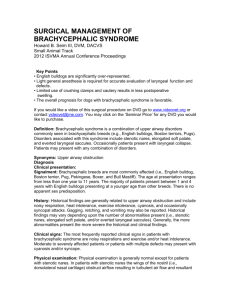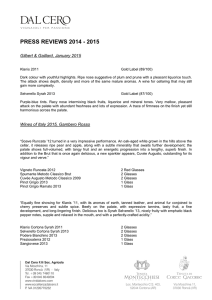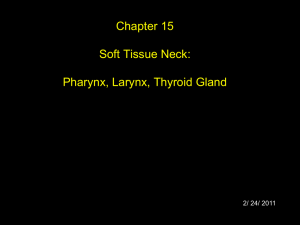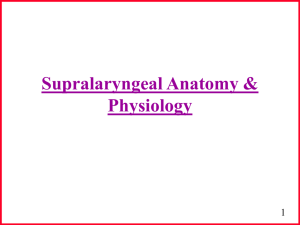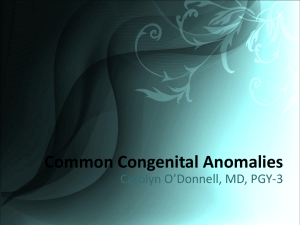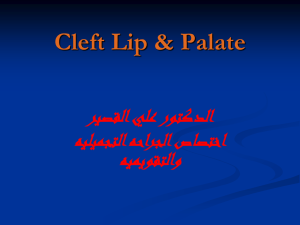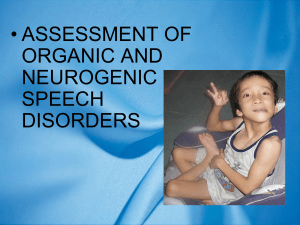BRACHY-SYND
advertisement
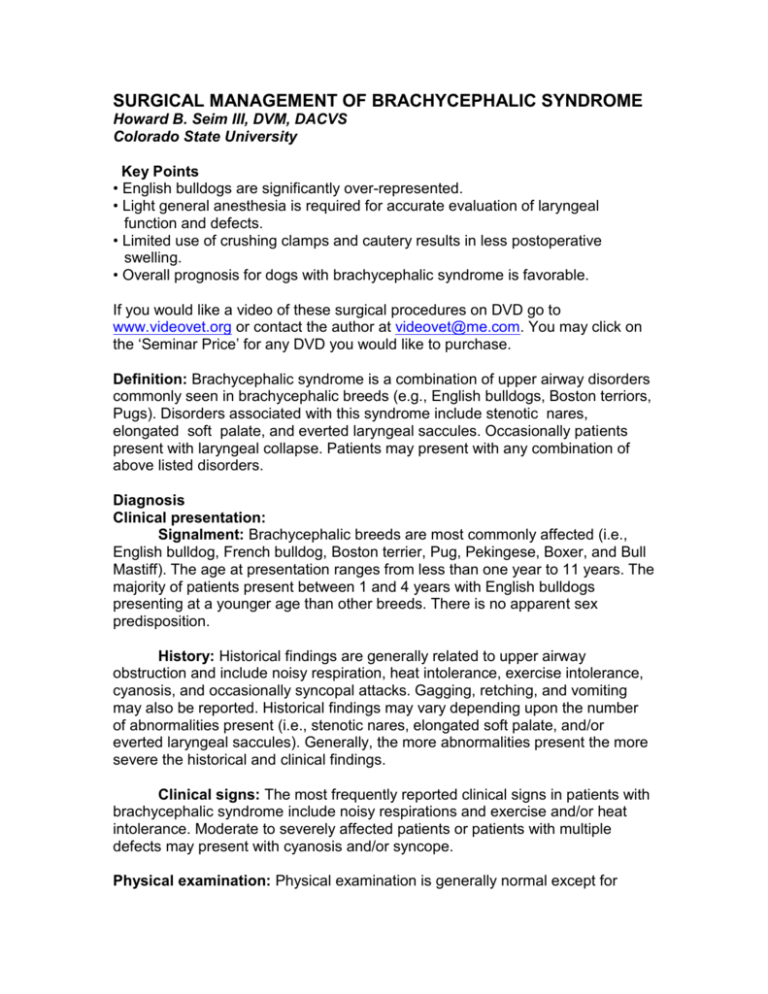
SURGICAL MANAGEMENT OF BRACHYCEPHALIC SYNDROME Howard B. Seim III, DVM, DACVS Colorado State University Key Points • English bulldogs are significantly over-represented. • Light general anesthesia is required for accurate evaluation of laryngeal function and defects. • Limited use of crushing clamps and cautery results in less postoperative swelling. • Overall prognosis for dogs with brachycephalic syndrome is favorable. If you would like a video of these surgical procedures on DVD go to www.videovet.org or contact the author at videovet@me.com. You may click on the ‘Seminar Price’ for any DVD you would like to purchase. Definition: Brachycephalic syndrome is a combination of upper airway disorders commonly seen in brachycephalic breeds (e.g., English bulldogs, Boston terriors, Pugs). Disorders associated with this syndrome include stenotic nares, elongated soft palate, and everted laryngeal saccules. Occasionally patients present with laryngeal collapse. Patients may present with any combination of above listed disorders. Diagnosis Clinical presentation: Signalment: Brachycephalic breeds are most commonly affected (i.e., English bulldog, French bulldog, Boston terrier, Pug, Pekingese, Boxer, and Bull Mastiff). The age at presentation ranges from less than one year to 11 years. The majority of patients present between 1 and 4 years with English bulldogs presenting at a younger age than other breeds. There is no apparent sex predisposition. History: Historical findings are generally related to upper airway obstruction and include noisy respiration, heat intolerance, exercise intolerance, cyanosis, and occasionally syncopal attacks. Gagging, retching, and vomiting may also be reported. Historical findings may vary depending upon the number of abnormalities present (i.e., stenotic nares, elongated soft palate, and/or everted laryngeal saccules). Generally, the more abnormalities present the more severe the historical and clinical findings. Clinical signs: The most frequently reported clinical signs in patients with brachycephalic syndrome include noisy respirations and exercise and/or heat intolerance. Moderate to severely affected patients or patients with multiple defects may present with cyanosis and/or syncope. Physical examination: Physical examination is generally normal except for patients with stenotic nares. In patients with stenotic nares the wings of the nostril (i.e., dorsolateral nasal cartilage) obstruct airflow resulting in turbulent airflow and resultant noise. Examining the patient after exercise may exacerbate clinical signs (i.e., noise and exercise intolerance) making diagnosis of brachycephalic syndrome more likely. Oral examination of the awake patient is generally unrewarding as the laryngeal apparatus and related abnormalities cannot be seen without light general anesthesia. Radiography: Diagnosis of brachycephalic syndrome is based on signalment, history, physical examination, and direct visualization of the laryngeal apparatus with the patient under light general anesthesia. Thoracic radiographs are generally recommended to rule out lower airway disorders such as tracheal hypoplasia and pulmonary abnormalities. Differential diagnosis: Any disorder causing noisy respirations, exercise intolerance, cyanosis, and syncope. Included are laryngeal mass, laryngeal collapse and laryngeal paralysis. Medical management: Medical management is directed at decreasing airway turbulence and subsequent inflammation and edema. Strict confinement, antiinflammatory medications (e.g., steroids, NSAIDS), and a cool environment are recommended. Obese patients should be placed on a weight reduction diet plan. As medical management does nothing to change the anatomic deformity of the disorder, it is considered palliative but not curative. Surgical treatment: The objective of surgical treatment is to provide an adequate airway by relieving any anatomic obstruction. Preoperative management: Use of anti-inflammatory medication preoperatively is generally recommended. Patients are given intravenous steriods (dexamethasone 0.5 - 1 mg/kg IV) at the time of anesthetic induction. Anesthesia: Anesthetic management is somewhat dependent upon the severity of clinical signs at presentation and degree of airway abnormality. Patients with mild signs may be anesthetized with the clinicians’ standard anesthetic protocol. Careful evaluation of the laryngeal apparatus is performed prior to intubation and while the patient can still breath on its own (i.e., light general anesthesia). Laryngeal function is carefully evaluated during inspiration and expiration. Patients with moderate clinical signs may need to be preoxygenated prior to induction. Induction should be performed quickly, the laryngeal anatomy and laryngeal function examined thoroughly, and the patient intubated to establish an open airway. Patients with severe clinical signs should be preoxygenated 5 to 10 minutes prior to induction. A vagolytic agent (i.e., atropine) should be considered 10 to 15 minutes prior to induction because vagal tone is generally increased and cardioinhibitory reflexes are enhanced. Induction should be quick, examination of the laryngeal anatomy and function performed, and the patient intubated to establish an open airway. Laryngeal examination: Once the patient is under a light plain of anesthesia laryngeal function is evaluated. Care is taken to observe for evidence of largngeal collapse, elongated soft palate, and everted laryngeal saccules. Surgical anatomy: The soft palate in the dog forms a long and broad movable partition between the oral and nasopharynx. The cranial border is attached to the bony palate; the caudal margin forms the dorsal border of the opening from the mouth into the pharynx. This portion of the palate is in contact with the epiglottis during normal inspiration; during deglutition, the epiglottis moves away from the soft palate to protect the opening of the glottis. At the same time the soft palate moves dorsally to close the nasopharynx and prevent regurgitation of material into the nasal cavity. The dorsal nasopharyngeal surface has a mucous membrane lining continuous with that of the nasal cavity and a slightly convex contour. The mucous membrane of the ventral concave surface is a continuation of the lining of the hard palate and is referred to as the oral surface of the soft palate. Relevant pathophysiology: Protrusion of an elongated soft palate into the laryngeal inlet during respiration significantly obstructs air passage into the glottis. Stenotic nares, when present, contribute to the severity of the occlusion by increasing the inspiratory effort (and subsequent negative pressure) thus drawing the soft palate deeper into the larynx. Edema and inflammation result from friction against the epiglottis during each respiration. The resultant thickening further lessens airflow. As increased inspiratory effort continues, increased negative pressure in the airway encourages laryngeal saccules to evert. Positioning: Patients may be positioned in ventral or dorsal recumbancy. Stenotic nares: The author prefers ventral recumbancy with the head supported on towels so the head position is normal and functional. Elongated soft palate and everted saccules: Patients can be operated in either ventral or dorsal recumbancy. In dorsal recumbancy, the maxillary canine teeth are taped securely to the operating table. The mandibular canine teeth are taped to an ether stand situated over the patients head. The mouth is opened wide to enhance visualization. This positioning is critical as oral cavity exposure is key to adequate visualization and instrumentation. In ventral recumbancy, the maxillary canine teeth are ‘hooked’ over the bar of an ether stand. The mandibular canine teeth are then taped to the operating table in such a fashion that the mouth gapes open. The tongue is grasped with tongue forceps and gently pulled from the mouth. Surgical technique: The surgical technique varies depending upon the defect to be repaired. Stenotic nares: This technique is illustrated on the Respiratory Surgery I DVD available via www.videovet.org. Stenosis is decreased by removing a horizontal wedge of alar cartiladge from the wing of the nostril. The flap created is sutured to remaining tissue of the wing of the nostril using 3-0 or 4-0 Dexon or Vicryl in a simple interrupted suture pattern. Two or three sutures is all that is generally required to complete the nasoplasty. An alternate technique gaining popularity in Shih Tzu and Boston breeds is to completely excise the alar cartilage. Bleeding is controlled by wedging a gauze sponge in the patient’s nostril for 5 minutes by the clock. Presurgical temporary tracheostomy?: Use of a presurgical tracheostomy facilitates exposure and visualization of the soft palate and laryngeal saccules. However, it is not necessary in the majority of patients. The author considers use of a tracheostomy in patients that present with severe clinical signs (i.e., cynosis, syncope) and have a combination of defects to repair. Tracheostomy is preferred over exiting the endotracheal tube through a pharyngostomy as the tracheostomy can be used in the postoperative management of the patient if necessary. In our hospital, regardless of the severity of the airway obstruction, the patient is recovered in a critical care environment and instruments necessary to perform an emergency tracheostomy are readily available. Elongated soft palate: This technique is illustrated on the Respiratory Surgery I DVD available via www.videovet.org. The patient is placed in ventral or dorsal recumbancy with the mouth opened widely (see positioning). A broad malleable retractor is used to retract the tongue caudally; this greatly facilitates visualization of the soft palate and laryngeal structures. A headlamp facilitates visualization but is not necessary. Since postoperative edema and swelling are of major concern following soft palate surgery, it is important to keep surgical trauma to a minimum. Use of clamps and electrocautery may cause excessive surgical inflammation and should be avoided. The soft palate is evaluated for extent of resection. A Babcock or Allis tissue forceps is used to grasp the caudal margin of the soft palate. The length of the soft palate in relation to the tonsil and epiglottis is examined. The soft palate should extend no further caudal than the midpoint of the tonsil. Alternately, the incision is made at the point where the soft palate just slightly overlaps the tip of the epiglottis. Once this line of excision is determined, a 3-0 or 4-0 Dexon or Vicryl stay suture is placed in the soft palate on each lateral margin of the proposed excision. A third stay suture is placed on the margin of the central portion of the soft palate. The incision is begun from the left or right margin and one-third to one-half of the soft palate is incised. Using the long end of one of the 3-0 or 4-0 Dexon or Vicryl stay sutures, the incised nasal mucosa is sutured to the incised oral mucosa using a simple continuous suture pattern. Dexon or Vicryl is chosen because of its soft supple nature; Maxon or PDS are much to stiff and may cause irritation to the oral cavity. Hemorrhage is controlled by suture pressure. No attempt is made to cauterize or clamp bleeding vessels. When the palate excision and suturing are complete, the stay sutures are cut and the remaining soft palate replaced and evaluated once again for extent of resection. Everted laryngeal saccule resection: There is some suggestion that if the stenotic nares and elongated soft palate can be successfully treated (see above), the lateral saccules will return to their normal location in the larynx and no longer cause airway obstruction without the need for surgical resection. The author only removes lateral saccules in patients that present with severe respiratory signs (i.e., severe cyanosis, syncope). When removing laryngeal saccules, the patient is placed in dorsal recumbancy with the mouth opened widely. Everted laryngeal saccules appear as edematous, translucent tissue balls lying in the ventral aspect of the glottis and obscuring the vocal folds. Surgical removal is performed using a sharp long-handled laryngeal cup biopsy forceps (or similar long handled biopsy instrument) or a long handled Allis tissue forceps and #15 BP scalpel blade. If a laryngeal cup biopsy forceps is used the everted saccule is grasped and amputated with the biopsy forceps. Any remaining tags are grasped with a long-handled DeBakey forceps and trimmed with a #15 BP blade or scissors. If an Allis tissue forceps is used the laryngeal saccule is grasped with the Allis forceps and a long-handled scalpel with a #15 BP blade is used to excise the saccule at its base. If the patient had a tracheostomy tube placed prior to surgery, the saccules are easily visualized and excised as described above. If the patient has an endotracheal tube exiting the laryngeal apparatus, the tube is temporarily removed while the saccules are excised. Suture material/special instruments: Malleable retractors, head lamp, long-handled laryngeal cup biopsy forceps (or similar instrument), long-handled Allis tissue forceps, long-handled scalpel handle, long-handled rat tooth forceps, 3-0 or 4-0 Dexon or Vicryl with a cutting or sharp taper needle. Postoperative care and assessment: Any patient requiring surgery to relieve airway obstruction should be monitored carefully (preferably in a critical care environment) for the first 24 hours postoperatively. The degree of care may vary depending upon the patients presenting signs and surgical manipulations required to correct the airway obstruction. Examples of the authors’ degree of postoperative care based on patient presentation and surgery performed are listed below: Stenotic nares only: These patients are generally held for observation 12 – 24 hrs postoperatively and discharged from the hospital the day following surgery. Soft palate resection only: Patients that present with mild clinical signs (i.e., noise, mild exercise or heat intolerance) and are bright and alert 24 hours after surgery can be discharged that day. Patients that present with moderate to severe clinical signs (i.e., severe exercise intolerance, episodes of cyanosis, syncopal attacks) are monitored in a critical care environment until signs resolve. Immediate postoperative gagging and coughing are observed in about 13% of patients. Patients requiring a tracheostomy prior to surgery, or an emergency tracheostomy, remain in a critical care environment until the tracheostomy can be removed. Combined nares, palate, saccule repair: These patients are treated similarly to patients with soft palate resection and are based on presenting clinical signs. Patients with multiple defects tend to present with moderate to severe clinical signs and may require more intensive care. Immediate postoperative gagging and coughing are observed in about 80% of patients. Patients that present with mild clinical signs (i.e., noise, mild exercise or heat intolerance) and are bright and alert 24 hours after surgery can be discharged that day. Patients that present with moderate to severe clinical signs (i.e., severe exercise intolerance, episodes of cyanosis, syncopal attacks) are monitored in a critical care environment until signs resolve. Patients requiring a tracheostomy prior to surgery, or an emergency tracheostomy, remain in a critical care environment until the tracheostomy can be removed. Prognosis: Prognosis for patients with brachycephalic syndrome is generally dependant upon the defects found at presentation. Stenotic nares only: About 96% of dogs with stenotic nares will improve postoperatively. Soft palate resection only: About 85 – 90% of dogs with soft palate resection only will improve postoperatively. Young dogs (i.e., less than 2 years of age) are more likely to improve (90%) than dogs greater than 2 years of age (70%). Stenotic nares and soft palate resection: Dogs having a combination of stenotic nares repair and soft palate resection are more likely to have a favorable outcome (96%) compared to those that did not (70%). Soft palate and everted saccule resection: Dogs having this combination of defects repaired will have an 80% chance of significant improvement postoperatively.
